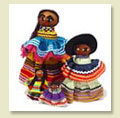Seminole History
A Brief History of the Seminole People in Florida
The ancestors of today's Seminole people migrated to Florida in the 1700s and early 1800s. These Indians came primarily from Alabama and Georgia, and although they were simply known as "Creeks" to the British, they spoke different languages and lived in independent towns. Different bands of Creeks established towns in north Florida and traded with both the British and Spanish. After 1765, all Florida Indians were referred to as "Seminoles." The name comes from the Spanish word cimarrón which means "wild" or "runaway." However, a more fitting interpretation may be "free."
 The first half of the nineteenth century was tumultuous for Florida's Seminoles. The U.S. military waged three wars against them; in fact, the Second Seminole War resulted in the majority of Seminoles being removed to Indian Territory (present-day Oklahoma.) Less than 200 survivors retreated deep into the Everglades and the military ended its hunt for them.
The first half of the nineteenth century was tumultuous for Florida's Seminoles. The U.S. military waged three wars against them; in fact, the Second Seminole War resulted in the majority of Seminoles being removed to Indian Territory (present-day Oklahoma.) Less than 200 survivors retreated deep into the Everglades and the military ended its hunt for them.
The Seminoles lived in virtual isolation in and around the Everglades for many years. They lived in open-sided structures called chickees, which were adapted to the swampy environment. They survived by hunting, gathering wild foods, and growing crops like corn, pumpkins, and potatoes. As white settlers began moving to south Florida, they established trading posts. The Seminoles sold animal hides and pelts to the traders and in turn bought cloth, guns, tools, and food staples. This way of life lasted into the twentieth century.
The great influx of settlers and drainage of the Everglades hastened the end of the trading post era. As a result, some Seminoles entered new tourist attractions in Miami. Seminole exhibition villages were a large part of the tourist scene in south Florida from the 1920s to the 1960s. At these villages, men wrestled alligators to the delight of crowds. Both men and women made crafts such as dolls, baskets, and carvings to sell to the tourists. These seasonal jobs in the villages provided important income, and the exhibition nature of the attractions enabled some of the traditional ways to continue. Seminoles maintain involvement in Florida's tourism industry today.
 A typical scene at tourist villages included women sewing colorful patchwork clothing. This colorful style of clothing is one of the most recognizable aspects of Seminole culture today. Seminole women invented patchwork around 1917. To make patchwork clothing, different colored strips of cloth are sewn together, then cut and reassembled to make rows of designs. The rows are sewn together horizontally to form the garment. Hand-cranked sewing machines allowed women to experiment with many designs. Designs became more intricate over time. The Seminole people wore patchwork clothing, and sold it to tourists. Patchwork clothing is still part of the Seminoles' traditional dress today.
A typical scene at tourist villages included women sewing colorful patchwork clothing. This colorful style of clothing is one of the most recognizable aspects of Seminole culture today. Seminole women invented patchwork around 1917. To make patchwork clothing, different colored strips of cloth are sewn together, then cut and reassembled to make rows of designs. The rows are sewn together horizontally to form the garment. Hand-cranked sewing machines allowed women to experiment with many designs. Designs became more intricate over time. The Seminole people wore patchwork clothing, and sold it to tourists. Patchwork clothing is still part of the Seminoles' traditional dress today.
In the 1890s, the government attempted to address the question of where the Seminoles should live by setting aside parcels of land. These parcels eventually became reservations. The first three established were Big Cypress, Dania (now Hollywood), and Brighton. The land was unimproved and there were no incentives for the people to move. The Civilian Conservation Corps-Indian Division, a program of the New Deal, employed Seminole men to build roads, fences, wells, and make other land improvements on the reservations. Seminoles slowly started moving onto the reservations in the late 1930s. A cattle program was also started at Brighton Reservation in 1936, and it is still a success story today.
In the early 1950s, Seminole leaders, to avoid being cut-off from government funding, decided to organize as a federally-recognized sovereign tribe. The Seminole Tribe of Florida was recognized in August 1957. The Tribe operates under a Constitution, Bylaws, and Corporate Charter. Its governing body consists of an elected five-member tribal council. An elected board of directors oversees the federally-chartered corporation, Seminole Tribe of Florida, Inc. The Tribe today has approximately 3,200 members.
After many years of economic struggles, the Seminoles achieved their goal to be self-sufficient and not reliant on the federal government for money. Their sovereignty allows the business ventures like casinos that permit them to be financially independent. In fact, the Seminole Tribe of Florida is one of the most successful Native American tribes in the country, and it has paved the way for other tribes' involvement in gaming. Importantly, because of their new-found wealth, the Tribe is able to provide for its members, especially in health care, housing, employment, and education.
The Seminole people of Florida have persevered despite the many social, political, and economic pressures brought against them. They have proven to be successful at adapting to new circumstances while still preserving important aspects of their culture.



